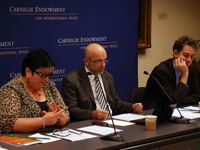Registration
You will receive an email confirming your registration.
IMGXYZ3215IMGZYXMore than three years after the August 2008 conflict over South Ossetia, the situation in the region remains deadlocked. However, some people-to-people contacts have resumed.
Carnegie hosted Lira Kozaeva of the Association of South Ossetian Women for Democracy and Human Rights and Archil Gegeshidze of the Georgian Foundation for Strategic and International Studies in a presentation of the findings of research paper analyzing the possibilities for confidence building between South Ossetia and Georgia. They were joined by George Mason University’s Susan Allen Nan. Carnegie’s Thomas de Waal moderated.
Georgian-South Ossetian Conflict: Researching Peace
- Intellectual cooperation: The research paper, entitled Georgian-South Ossetian Conflict: Researching Peace, represents a unique case of intellectual cooperation between the South Ossetian and Georgian civil society representatives in assessing the events and aftermath of 2008, explained Nan.
- Results: The report includes parallel analyses of the main disagreements between South Ossetians and Georgians regarding the legal status of South Ossetia, interpretation of the war itself, a discussion of possible solutions to the problem of internally displaced persons and refugees, and recommendations on the peace building process and restoring confidence between peoples in the region.
- Limitations: In assembling the report, both parties faced severe limitations in the availability of reliable information, Gegeshidze added. The participants said that even making contact for their first meeting in 2008 was difficult but both sides now have a much better understanding of the other.
- Georgian-Ossetian relations: Both Kozaeva and Gegeshidze argued that the tensions between Georgians and Ossetians, which had increased in the early 1990s, had all but died out by the 2000s. There was a lack of personal enmity between Georgians and Ossetians, facilitated by the presence of mixed families, economic cooperation, and free travel. Things worsened again, however, after the clashes of 2004.
- Ossetians in Georgia: Since the war in 2008, there was no noticeable exodus of about 30,000 Ossetians currently residing in Georgia, Gegeshidze said. For the most part, relations between Georgians and Ossetians living in Georgia have not worsened, he asserted. In addition, the need for cross-border economic cooperation is a common theme in all papers in the report, added Nan.
Way Out of Deadlock
The report offers shared observations from both Georgians and South Ossetians on a way out of current deadlock, explained Gegeshidze:
- Non-Use of Force: An agreement on the non-use of force would help to restore confidence between the two ethnic groups.
- Civil Society Dialogue: Deeper contacts between civil societies will help end the process of mutual alienation and ease the way towards greater mutual understanding.
- Perspectives for South Ossetia. There is no consensus in South Ossetia about what the region’s “national project” is, said Gegeshidze. Up until 2004 “I would have killed someone” who said that South Ossetia could not be part of Georgia, added Kozaeva. The events of 2008, however, had made South Ossetians take the project of independence more seriously, Kozaeva asserted.
